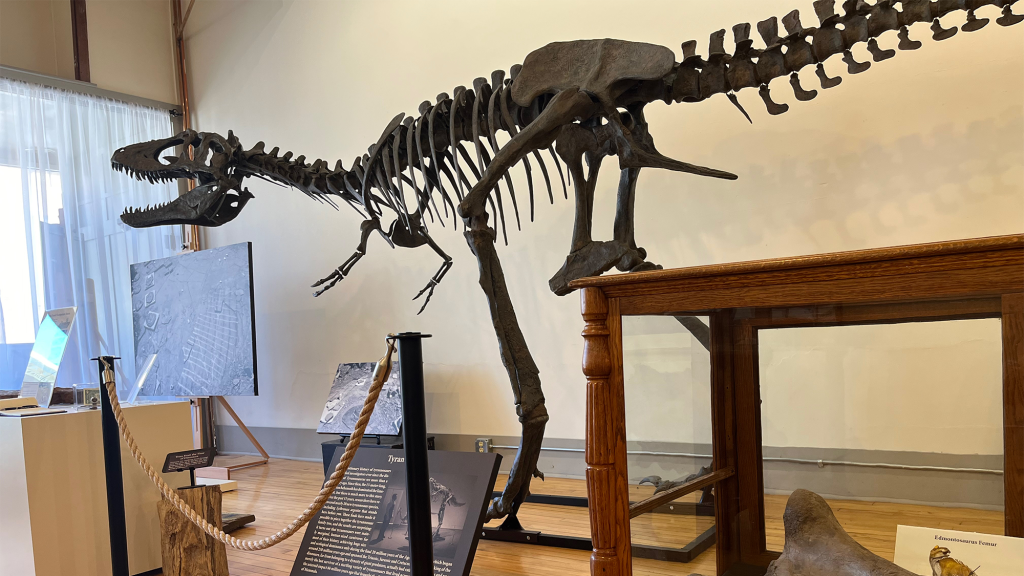When Jim Pollard first laid eyes on the small town of Blue Earth, Minnesota, he was out on a fossil digging trip with his sons. The town on the border of Iowa is surrounded by potential discovery sites–Quarry Hill Nature Center, Shadow Falls Park, and Lilydale Regional Park are all within a few hours drive away. When Pollard and his sons would drive in between their fossil digging locales and home in Wisconsin, Blue Earth was a perfect half-way point–a quaint town with a population of around 3,000.
Little did he know that years later, he’d be spearheading the effort to bring the fossil-filled Southern Minnesota Museum of Natural History to a 133-year-old building in the downtown of the tiny city.
“Kids stop in on the way back from the pool in their swimsuits,” he says. “They walk in, park their bikes outside. In that respect, it’s like Mayberry. It’s old school.”
Pollard is an artist by trade, but began his journey as an amateur paleontologist digging up fossils with his parents in his childhood (he says that his first major find was uncovered when he was around seven). When confronted with financial stress that landed him in the hospital during the Great Recession, the road to Blue Earth opened again–and an opportunity along with it.

While Pollard’s wife Bridget Gallagher was working as a substitute teacher at the local school, she noticed that many of the students were struggling academically. This got Pollard thinking on how he could help boost interest in science among Blue Earth’s youngest residents, and drew him to the library to test out his burgeoning curatorial skills. There, he filled up a display shelf with mini exhibits like one on linguistics and coding that featured an Enigma machine from World War II. But it was the fossils that really grabbed people–and kids–attention.
“I brought this big mammoth jaw and put that in the case, and that’s when things started to take off,” he said. “Then I could see the kids flock around it, and everyone was interested.”
[ Related: The Poozeum: Fossilized bug farts, T. rex poop, and more ancient coprolites. ]
After COVID-19 lockdowns shut down his library-based exhibit, it was time to take things to the next level. He formed a nonprofit to build a museum for these rural kids to get a hands-on taste of science and the history of the planet. He moved his fossils into a former antiques store on the quaint Blue Earth main street and got to gathering fossils and findings for the exhibits.

The stories behind the Southern Minnesota Museum of Natural History are nearly as interesting as the fossils themselves, which range from 7,000 to 7 million-years-old. Some of them are Pollard’s own finds from various digs, but many others were donated or hunted down in an old school way–on eBay. One such example: an array of 7,000-year-old bison bones rescued from destruction at a construction site in Coon Rapids, MN around 35 years ago by a pair of amateur fossil hunters. Pollard bartered with a fossil collector in South Dakota who had purchased the bison bones from its original discoverers. Another internet friend in Siberia sent Pollard a bag of mammoth poop that is so well-preserved that visitors can see the imprints of grass the ancient beast had eaten.
“Each of the displays has stories, usually by the person collecting the fossils,” Pollard adds. “That storytelling is what interests kids.”

Pollard says that the museum is a bit like the “Mona Lisa”–small but packs a punch. There’s not a lot in terms of technology, so visitors shouldn’t expect any QR codes or animatronic T-rexes. And Pollard isn’t particularly interested in expanding the size of the museum too much. Instead, donations help keep the small building and its ancient inhabitants afloat.
What he really wants funding for, he says, is a unique program they began this summer that takes one child from Blue Earth out to a dig site every summer to do some hands-on discovery. This year’s recipient packed his mom’s car full of 300 pounds of fossils from a site called Elk Creek that cuts through about 3 million years of deposits.
“The dig is not just about fossils, it’s about growing up,” Pollard says. “It’s about engaging in the physical world as well as the mental world and intellectual world. When you’re out on a dig, it’s like you set your watch back 50,000 years.”


